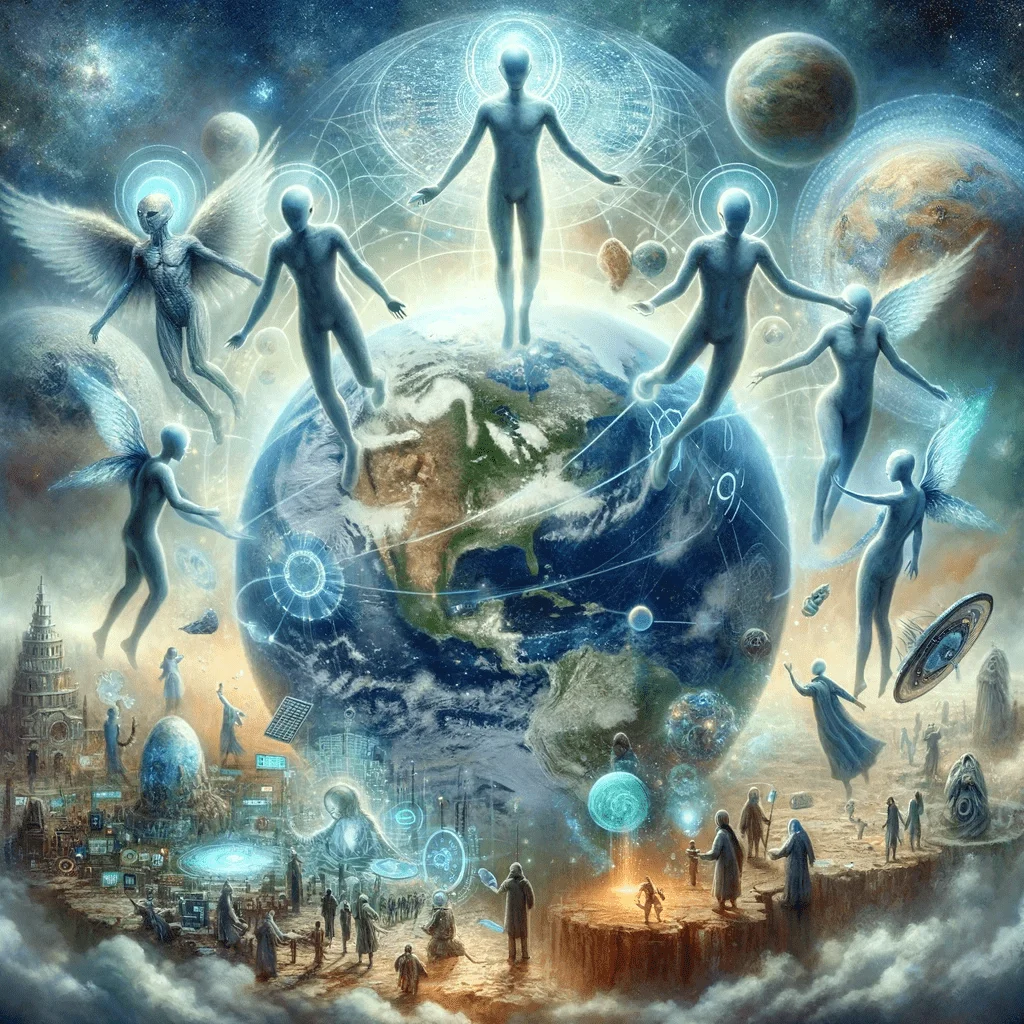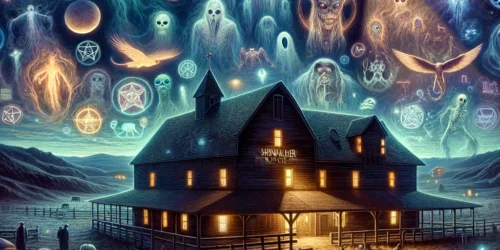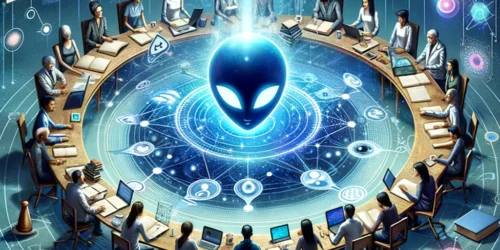The Curation of our Reality

The discovery and acceptance of non-human intelligent beings (NHI), widely known as aliens, has not just reshaped our understanding of the universe, but also challenged the foundational aspects of our reality. This radical shift propels us into a realm that mirrors iconic films such as “The Truman Show” and “The Matrix.” Interestingly, our unfolding reality seems more akin to the former but sure does contain aspects of both.
In “The Matrix,” reality is a computer-generated illusion designed to keep humanity subdued while their bodies provide energy to sentient machines. On the other hand, “The Truman Show” portrays Truman Burbank’s life as a 24/7 television show, unbeknownst to him. He lives in an artificial world, while the outside world watches, captivated.
The similarity of our existence to these films is underpinned by science, religion, philosophy and the human condition.
From a scientific perspective, UFOs and UAPs suggest that advanced civilizations are not just observing us but could be curating our reality—much like the producers in “The Truman Show.” The Fermi Paradox, which questions why we have not yet had contact with alien civilizations despite the high statistical probability, could be explained by the Zoo Hypothesis. This suggests that NHI beings might be deliberately avoiding contact, preferring to observe and possibly guide us without our knowledge.
The Zoo Hypothesis and the Shepherd and Flock analogy, both strive to explain the potential relationship between humanity and advanced civilizations. They share commonalities but are distinct in their implications and assumptions.
The Zoo Hypothesis, proposed by John A. Ball in 1973, posits that NHI civilizations consciously avoid contacting Earth to allow for natural evolution and sociocultural development, similar to zookeepers maintaining a hands-off approach to animals in a zoo. Beings, according to this hypothesis, observe us, possibly out of scientific curiosity, without intervening in our affairs. The underlying principle is the preservation of our natural habitat and behavior, without the influence or disturbance caused by advanced civilizations.
From my personal UFO and alien abduction experience, the Shepherd and Flock analogy implies a more involved relationship. Beings serve as ‘shepherds,’ guiding humanity—the ‘flock’—through the course of our evolution. This is a more interactive and interventionist scenario, where the ‘shepherds’ might subtly influence our technological, social, and possibly even biological development. They might act to prevent us from self-destruction or help us navigate challenges that they themselves may have overcome in their history.
In comparing the two, the Zoo Hypothesis implies a more passive form of observation with non-intervention, respecting a ‘Prime Directive’ of sorts, similar to concepts in science fiction like Star Trek. Meanwhile, the Shepherd and Flock relationship suggests a more active role in human affairs, with intervention when necessary.
In the Shepherd and Flock relationship, the shepherd has a deep commitment to the flock, often going to great lengths to ensure their safety and well-being. A shepherd will guide the flock, provide for them, and may even risk personal harm or death to protect them. This analogy suggests that if advanced beings are acting as our ‘shepherds’, they have a vested interest in our survival and prosperity. This could manifest in different ways – guiding our technological advancement, helping us solve critical global issues, or even intervening to prevent global catastrophes.
If we consider the NHI beings as our shepherds, their approach might be similar to the entities controlling the Matrix in the movie. In the event of a self-destruction scenario, they could step in to help rebuild, utilizing their advanced knowledge and technologies. These beings might guide us to understand our past mistakes and learn from them, ensuring our civilization’s growth and advancement in the next cycle.
This cyclic evolution theory aligns well with many religious and philosophical teachings, hinting at the interconnectedness of destruction and creation, death and rebirth. Just as a forest fire, while initially destructive, can clear the way for new growth and enhance the overall health of the forest, the self-destruction and subsequent renewal of a civilization could lead to a more advanced and enlightened society.
Conversely, the Zoo Hypothesis, like a zookeeper’s relationship with the animals, suggests a more detached involvement. A zookeeper ensures the overall welfare of the animals and maintains a safe environment for them but typically does not intervene in the animals’ internal dynamics or individual survival. The relationship is one of observation, preservation, and non-interference, rather than close involvement or guardianship.
Both theories could provide plausible explanations for the Fermi Paradox—the apparent contradiction between the high probability of NHI life and the lack of evidence or contact with such civilizations. However, each implies a different stance on the ‘non-interference’ principle and a different ethical and philosophical outlook on the part of the hypothetical advanced civilization.
In the realm of quantum physics, the simulation theory posits that our reality might be a sophisticated simulation created by a technologically superior civilization. This correlates with the virtual reality in “The Matrix”. However, the active intervention and control displayed by beings are more reminiscent of “The Truman Show.”
Religion, too, offers a similar narrative. Most religious texts speak of higher beings—gods—who watch over humanity, intervene in our affairs, and guide our moral and ethical compass, not unlike the creators of Truman’s world. These parallels become even more compelling when the said higher beings are envisioned as technologically advanced NHI life forms.
Philosophically, both movies and our reality resonate with the ancient philosophical concept of Plato’s Cave. Here, people are trapped in a cave, seeing only shadows of reality. They believe this is all there is until one person escapes the cave and sees the actual world. Like Neo in “The Matrix” and Truman in “The Truman Show”, we too may be living in a limited perception of reality, a shadow play orchestrated by more advanced beings.
Despite the shared themes, our reality mirrors “The Truman Show” more closely. The idea behind “The Matrix”—a complete fabrication of reality—is more extreme, requiring advanced brain-computer interfaces, while “The Truman Show” only requires control over the environment and information flow, which aligns more with the plausible capabilities of advanced beings.
Moreover, in “The Matrix,” the illusion is dystopian, whereas “The Truman Show” portrays a benevolent deception. If we are indeed under observation by NHI beings, the fact that our world isn’t dystopian implies that their intervention is more Trumanesque.
At this point, it is prudent to consider that while we are intrigued by the potential benevolence of the shepherd-like entities, it is also necessary to contemplate the need for such protective intervention. Given the potential vastness of the cosmos and the possibility of countless civilizations within it, it is conceivable that not all NHI beings would harbor good intentions towards humanity. In fact, malevolent intentions might also exist.
In the grander scheme of our galactic neighborhood, we may be akin to a nascent civilization requiring guardianship against these potential threats, much like a flock needing protection from wolves. This could be another reason why our NHI shepherds remain hidden, for the overt revelation of their existence and their association with us could make us targets for malevolent entities. This shepherd-flock relationship could be not just about guiding us but also about protecting us, offering a shield of sorts against any cosmic malevolence.
The shepherd’s role may extend to providing a protective buffer while we grow and mature as a civilization, ensuring our survival against potential external threats. This adds another dimension to the Shepherd and Flock analogy, reinforcing the idea of a more active, protective relationship between humanity and our NHI shepherds.
The notion of NHI messages embedded within our culture – in music and movies, for example – is a fascinating one. While we often consider these mediums as purely human creations, if we extend our assumptions about the existence and interference of aliens in our world, the possibility of hidden messages within them becomes intriguing.
In regard to hidden messages in the music, it is an international language that crosses cultural and linguistic barriers. Advanced NHI civilizations could exploit this universality to communicate with us. Pulsating rhythms, frequency modulations, and complex harmonic structures could serve as carriers of encoded information. The famous ‘Golden Record’ aboard the Voyager spacecrafts, containing music from various Earth cultures, shows that we, too, view music as a viable medium for communicating our existence to potential NHI civilizations.
The question of the source of original thought, especially in creative pursuits like writing music and film, is a fascinating and complex one that touches on many different disciplines, from neuroscience to philosophy, psychology, and even spirituality.
From a neuroscience perspective, creativity is believed to originate from a unique interplay of neural networks in the brain. The ‘default mode network’ (DMN) associated with daydreaming, mind-wandering, and self-referential thinking seems to play a crucial role in creative thought. Another key component is the ‘executive control network,’ which focuses on goal-directed tasks and problem-solving. Original ideas often emerge from the interaction between these two networks, with the DMN generating novel ideas and the executive network evaluating and refining them.
From a more philosophical or spiritual standpoint, some believe that original thought could stem from a collective consciousness, a kind of universal mind that individual minds tap into. This idea, found in certain Eastern philosophies and Western mystical traditions, posits that creativity could be a process of tuning into this collective reservoir of ideas, symbols, and archetypes.
One might hypothesize that if NHI beings are influencing our reality, they could potentially be influencing our creative outputs too. This could take the form of subtle inspiration, nudging our thoughts in certain directions, or even direct communication of specific ideas or messages.
In the realm of cinema, movies have an unmatched capacity to influence and mirror societal thoughts. If we consider that advanced civilizations are shaping our reality à la “The Truman Show,” it’s possible they might embed messages, hints, or clues within popular films. Movies like “Close Encounters of the Third Kind” or “Contact” could serve as not just science fiction but as subtle vehicles of real cosmic truths.
The evidence available so far seems to align more with our reality being akin to “The Truman Show” with a touch of “The Matrix”. The interplay of science, religion, and philosophy offers compelling similarities between our existence and these iconic films, but ultimately, the Truman Show analogy holds the edge. Just like Truman, the more we learn and observe, the closer we might get to unveiling our reality’s true nature. The sky, it seems, is no longer the limit, but the stage of our most profound existential exploration.



